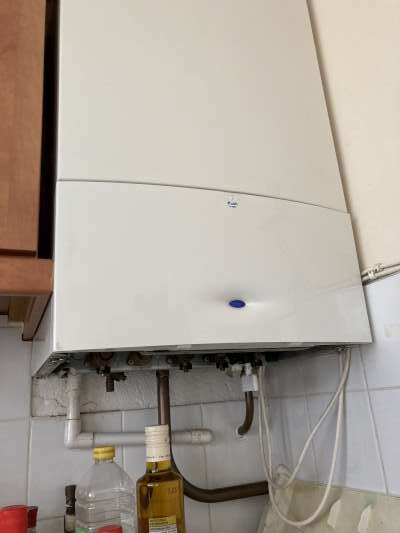I'm hoping that someone can give me some advice :
I have a Worcester condensing boiler. As fitted the boiler had a several meter long small bore condensate pipe leading to the nearest drain. This would always block up when the weather was sub-zero outside, so I had a much bigger drain line (black) fitted just below where the smaller bore line (white ) passes through the wall.
This works much better until the weather has stayed sub-zero for several days, in which case the larger drain also freezes up, the condensate line backs up with water and it spills out underneath the boiler creating a complete mess ! This happened again this week.
I considered putting trace heating on the condensate drain line, but this would be very difficult as no power source anywhere near, and this problem now only occurs on average about every two years when there is a prolonged period of sub-zero temperature.
I am wondering if the temporary solution that I have implemented makes sense ? I plan to leave a gap between the small bore white pipe and the larger bore (black) pipe. That way the water will normally drip down into the larger bore pipe, but if the larger bore pipe freezes up the water can still escape from the smaller bore pipe. I really can't see the smaller bore pipe freezing up as a relatively short length of it is fully exposed to the outside temperature, the condensate should be relatively warm at that point, and the air in the pipe might get a small amount of heat from the upstream part from the boiler.
This solution seemed to work for the past few days when the temperatures were still sub-zero. Any advice or suggestions would be much appreciated - I know that condensates pipes freezing up and blocking is a common problem now when we get prolonged periods of sub-zero temperatures. Some photos below. As fitted the black pipe covered the white pipe up to the ring of silicon sealant :
I have a Worcester condensing boiler. As fitted the boiler had a several meter long small bore condensate pipe leading to the nearest drain. This would always block up when the weather was sub-zero outside, so I had a much bigger drain line (black) fitted just below where the smaller bore line (white ) passes through the wall.
This works much better until the weather has stayed sub-zero for several days, in which case the larger drain also freezes up, the condensate line backs up with water and it spills out underneath the boiler creating a complete mess ! This happened again this week.
I considered putting trace heating on the condensate drain line, but this would be very difficult as no power source anywhere near, and this problem now only occurs on average about every two years when there is a prolonged period of sub-zero temperature.
I am wondering if the temporary solution that I have implemented makes sense ? I plan to leave a gap between the small bore white pipe and the larger bore (black) pipe. That way the water will normally drip down into the larger bore pipe, but if the larger bore pipe freezes up the water can still escape from the smaller bore pipe. I really can't see the smaller bore pipe freezing up as a relatively short length of it is fully exposed to the outside temperature, the condensate should be relatively warm at that point, and the air in the pipe might get a small amount of heat from the upstream part from the boiler.
This solution seemed to work for the past few days when the temperatures were still sub-zero. Any advice or suggestions would be much appreciated - I know that condensates pipes freezing up and blocking is a common problem now when we get prolonged periods of sub-zero temperatures. Some photos below. As fitted the black pipe covered the white pipe up to the ring of silicon sealant :
Last edited:




